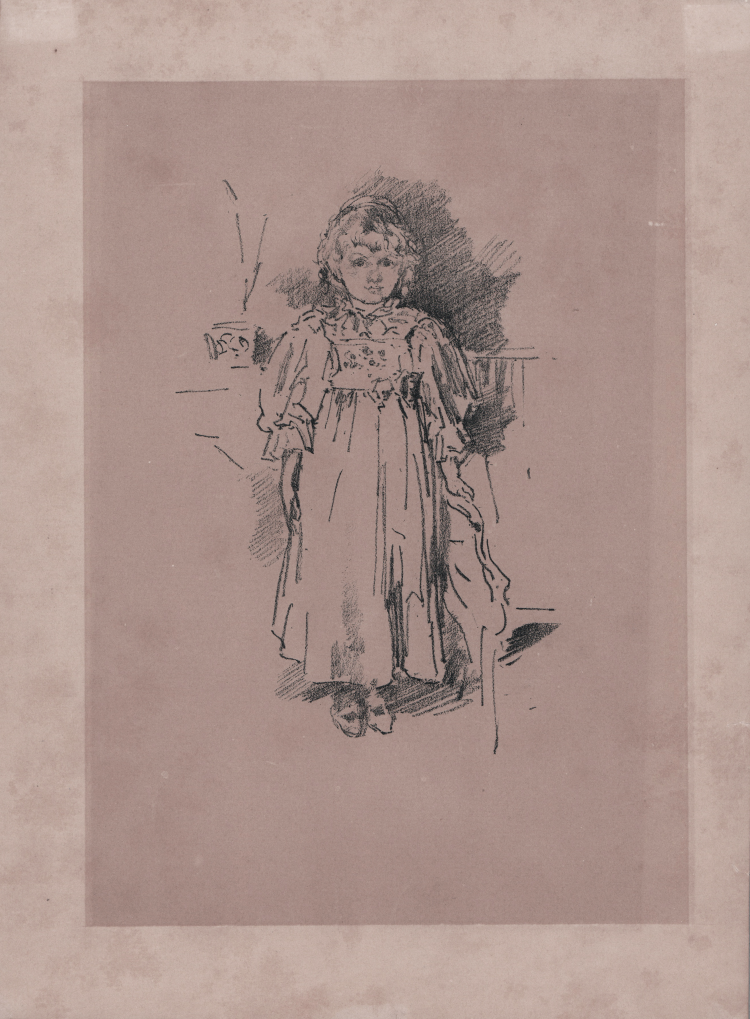



| Reference: | S5560 |
| Author | James Abbot MCNEIL WHISTLER |
| Year: | 1896 |
| Measures: | 180 x 250 mm |


| Reference: | S5560 |
| Author | James Abbot MCNEIL WHISTLER |
| Year: | 1896 |
| Measures: | 180 x 250 mm |
Transfer lithograph, 1896, drawn on white transfer paper with a grained-stone texture; only state; printed in black ink on the cream laid paper used for The Art Journal edition. In the stone at left: butterfly monogram.
The child who posed for this engaging portrait was the three - or four-year - old daughter of Whistler’s longtime friend, David Croal Thomson. Thomson had taken an interest in the artist’s work for many years and had organized the very successful retrospective of his paintings at the Goupil Gallery in the spring of 1892. He had served as editor of The Art Journal since November 1892 and had already published one of Whistler’s lithographs, Nursemaids: “Les Bonnes du Luxembourg” in the December 1894 issue of the periodical.
Whistler probably made the transfer drawing of Evelyn when he visited the Thomson family in January 1896 at their home outside London.
Some foxing, otherwise good condition.
Bibliografia
Margaret F. MacDonald, Grischka Petri, Joanna Meacock James McNeill Whistler: The Etchings, a catalogue raisonné, University of Glasgow , 2012, cat. no. 146.
James Abbot MCNEIL WHISTLER (Lowell, 10 luglio 1834 – Londra, 17 luglio 1903)
|
James Abbott McNeill Whistler was an American painter and engraver, rarely mentioned as James Whistler. A genius at producing intaglio engravings, Whistler was among the most inventive and influential printmakers in history, producing nearly 500 works over five decades. He approached engraving in 1857, at age 23, as a gifted and passionate young draftsman, using the technique of intaglio to record and reproduce quick sketches at a time when engraving was used as a mere reproductive technique. By the 18th century, in fact, art printing had become almost exclusively a means of reproducing works of art and portraits, and had become truly industrialized. Just at the end of the 19th century, with the birth and affirmation of photography, engraving was able to free itself from its utilitarian function, thanks to artists such as Whistler, who rediscovered the vitality and autonomy that had characterized it at the beginning. In his early years of experimentation with this technique he works outdoors, drawing on copper properly prepared, and then proceed to clamp in his room, touring Alsace-Lorraine and the Rhineland. In 1859 he moved to London, where he produced views of the Thames, remaining faithful to the purity of unadorned realism inspired by Japanese prints. At that time he also began to rub inks expressively and to work using the drypoint technique, preferring it to etching, for the production of portraits and figures. From September 1879 Whistler moved to Venice to produce twelve etchings, commissioned by the Fine Arts Society of London, which expected the return of the artist after a stay of three months. Instead, the artist stayed in the lagoon city fourteen months and produced fifty etchings, as well as one hundred pastels, reaching his creative peak. Etching offered Whistler the opportunity to combine speed of execution, drawing ideas quickly on the plate, with the ability to refine and develop them through multiple states, highlighting his complex aesthetic. His work, with such an innovative approach, not only attracted followers and imitators, but influenced the entire art world.
|
James Abbot MCNEIL WHISTLER (Lowell, 10 luglio 1834 – Londra, 17 luglio 1903)
|
James Abbott McNeill Whistler was an American painter and engraver, rarely mentioned as James Whistler. A genius at producing intaglio engravings, Whistler was among the most inventive and influential printmakers in history, producing nearly 500 works over five decades. He approached engraving in 1857, at age 23, as a gifted and passionate young draftsman, using the technique of intaglio to record and reproduce quick sketches at a time when engraving was used as a mere reproductive technique. By the 18th century, in fact, art printing had become almost exclusively a means of reproducing works of art and portraits, and had become truly industrialized. Just at the end of the 19th century, with the birth and affirmation of photography, engraving was able to free itself from its utilitarian function, thanks to artists such as Whistler, who rediscovered the vitality and autonomy that had characterized it at the beginning. In his early years of experimentation with this technique he works outdoors, drawing on copper properly prepared, and then proceed to clamp in his room, touring Alsace-Lorraine and the Rhineland. In 1859 he moved to London, where he produced views of the Thames, remaining faithful to the purity of unadorned realism inspired by Japanese prints. At that time he also began to rub inks expressively and to work using the drypoint technique, preferring it to etching, for the production of portraits and figures. From September 1879 Whistler moved to Venice to produce twelve etchings, commissioned by the Fine Arts Society of London, which expected the return of the artist after a stay of three months. Instead, the artist stayed in the lagoon city fourteen months and produced fifty etchings, as well as one hundred pastels, reaching his creative peak. Etching offered Whistler the opportunity to combine speed of execution, drawing ideas quickly on the plate, with the ability to refine and develop them through multiple states, highlighting his complex aesthetic. His work, with such an innovative approach, not only attracted followers and imitators, but influenced the entire art world.
|